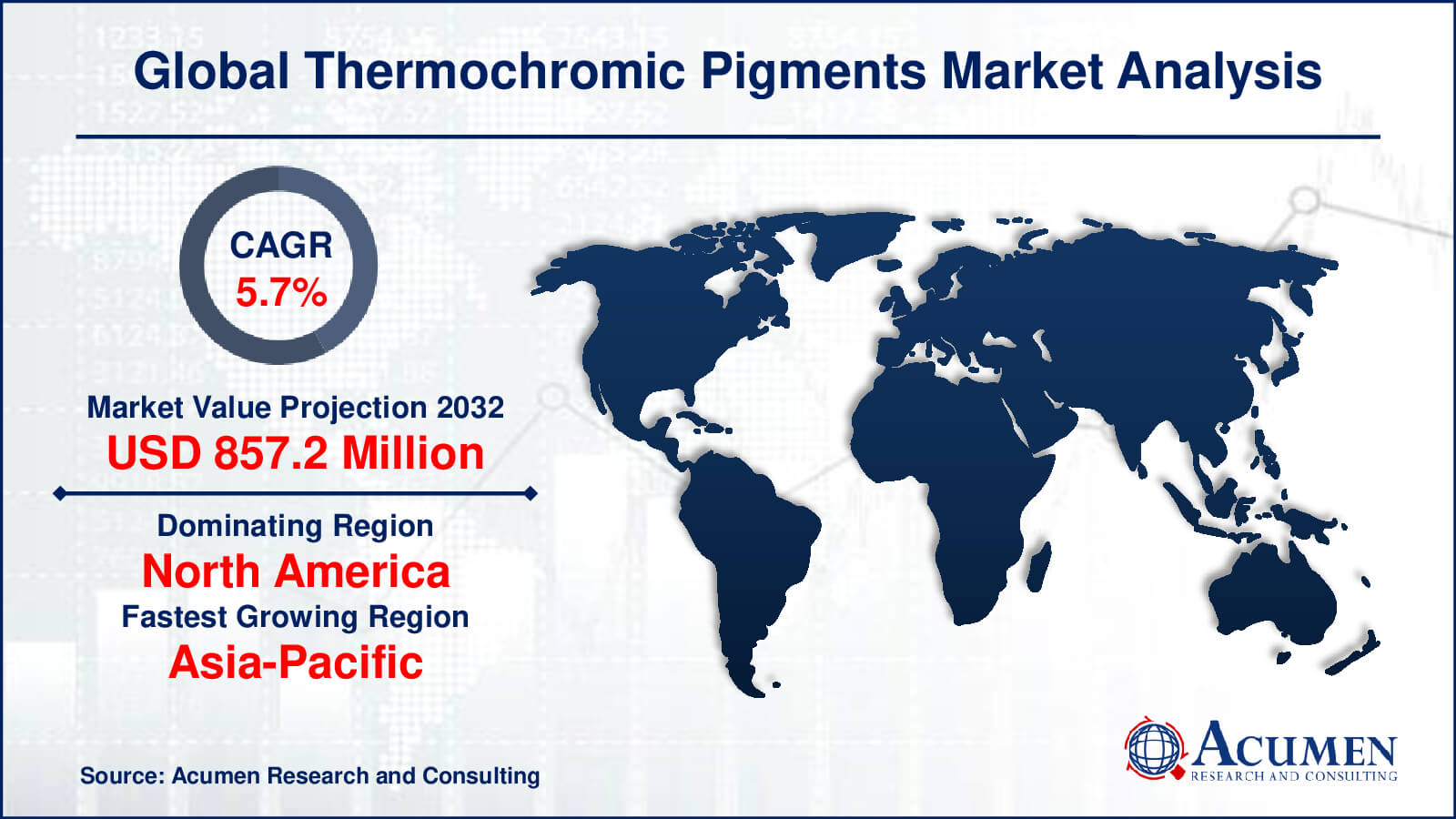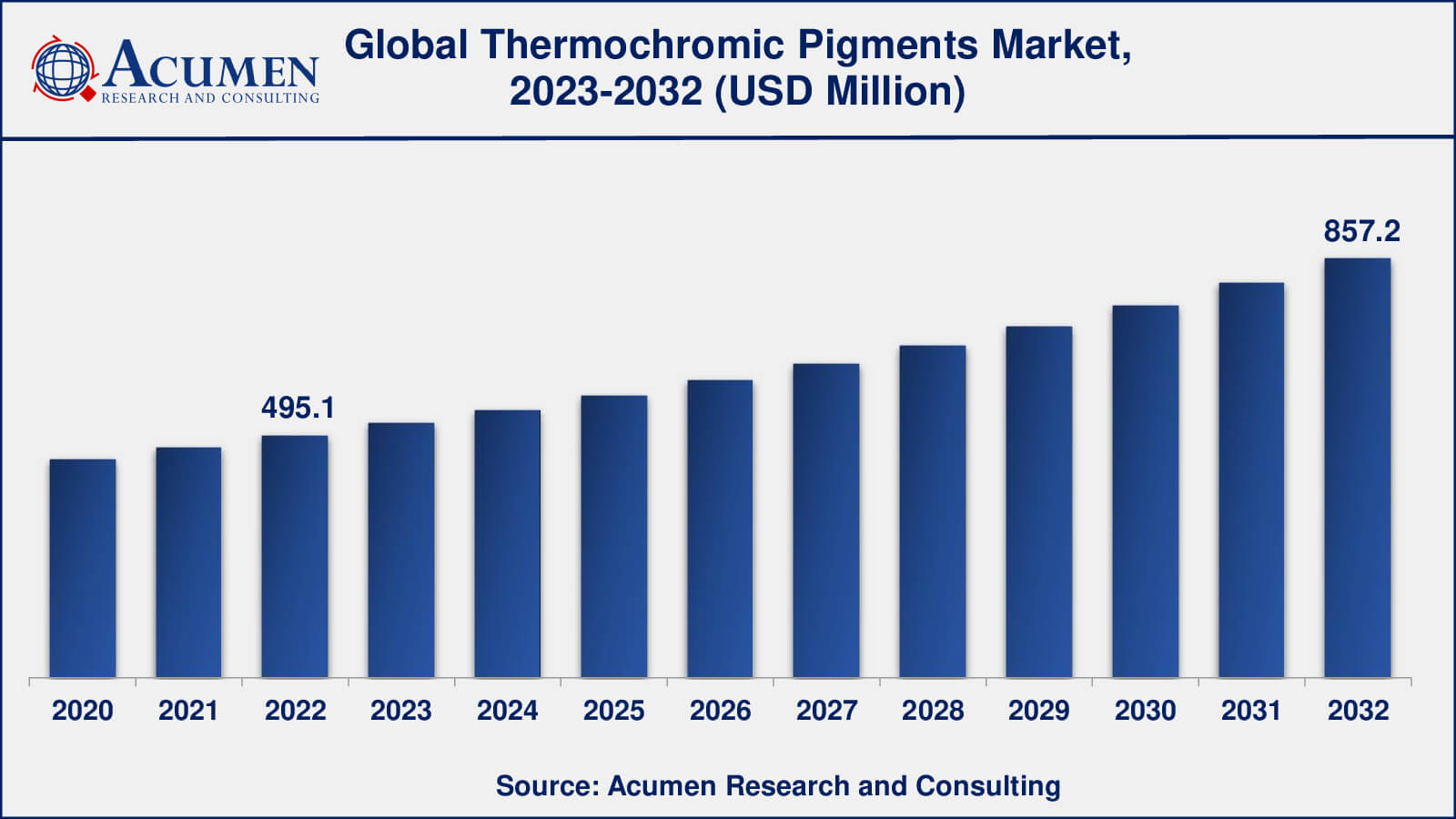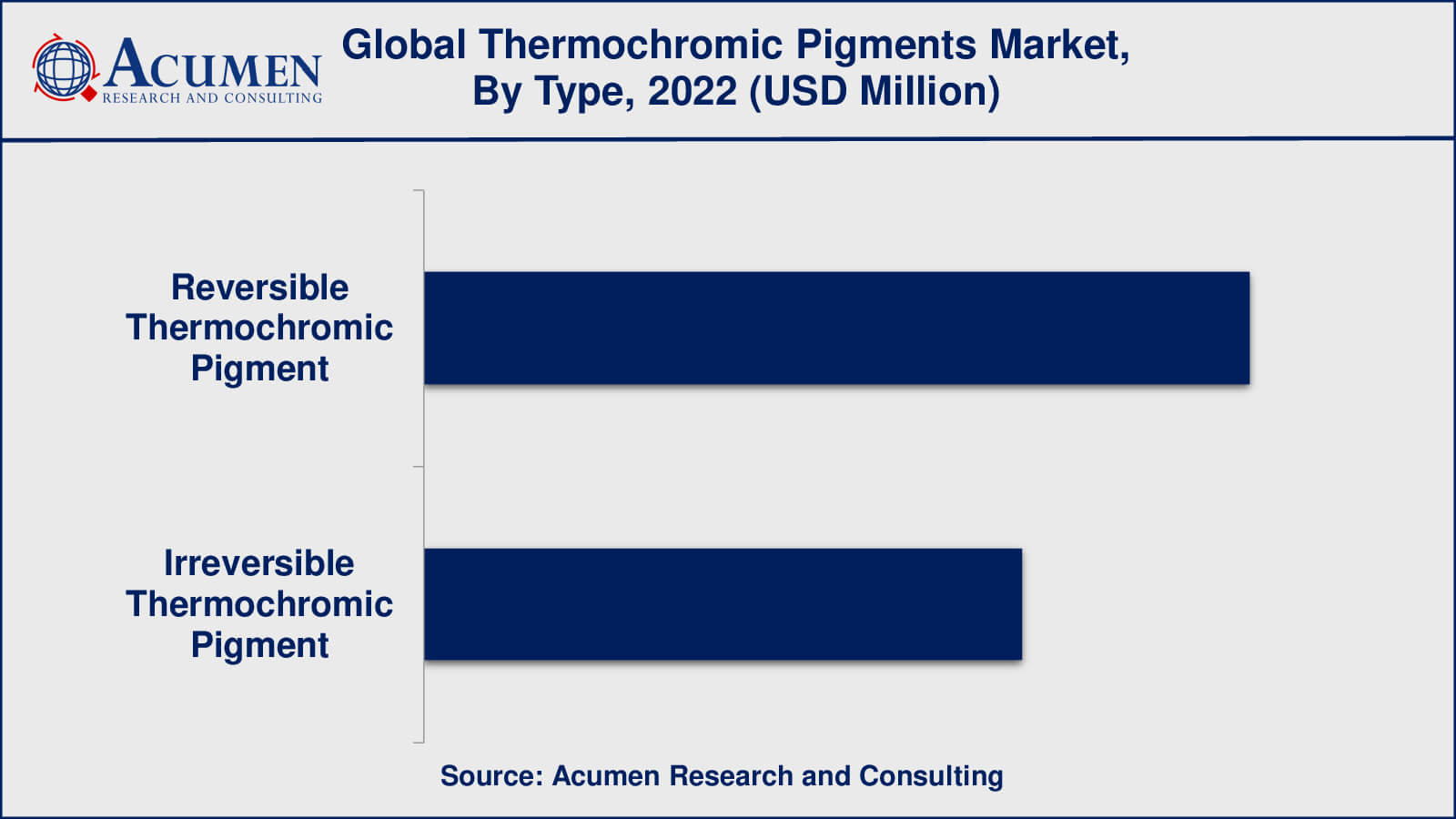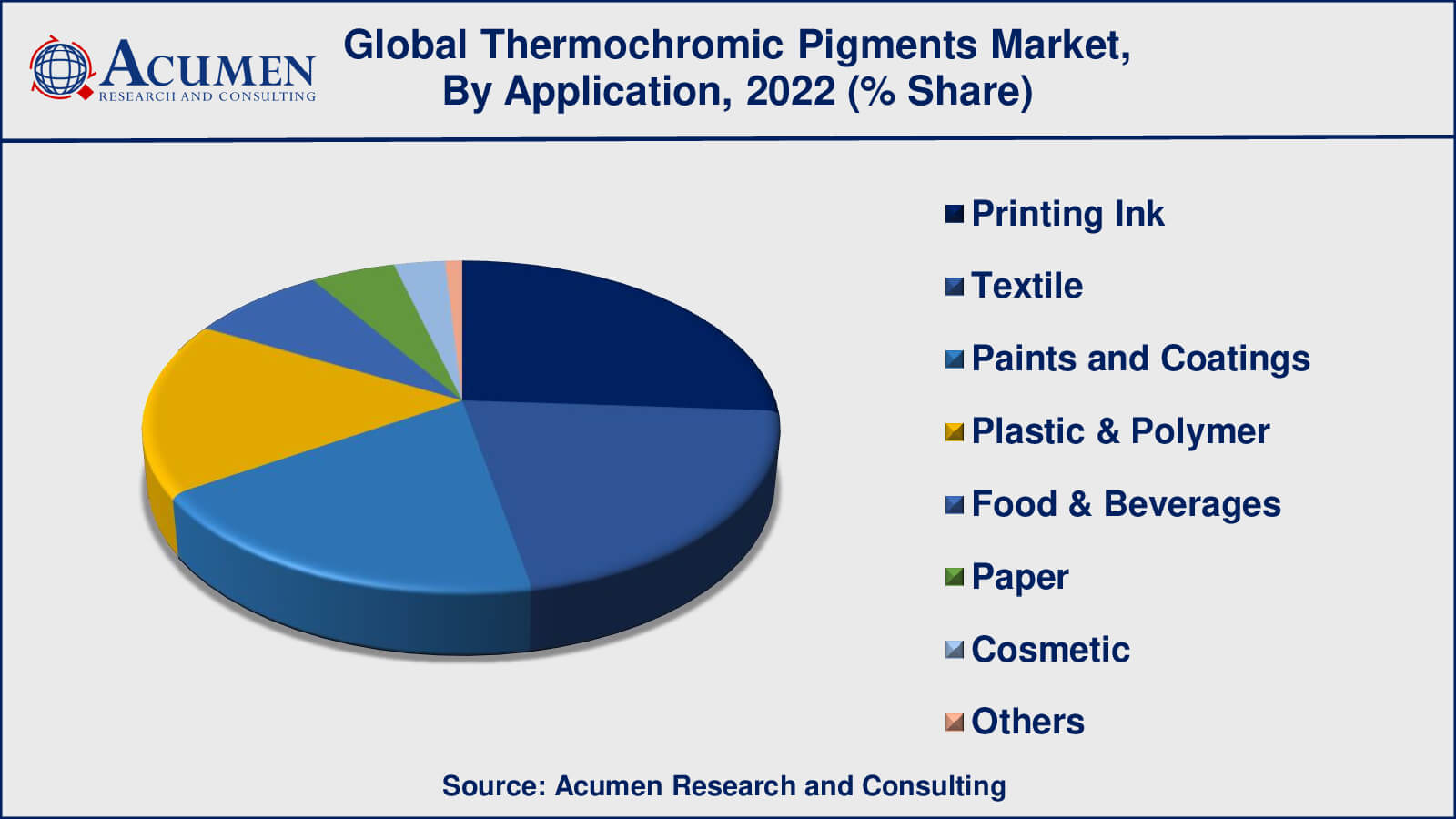August 2020
Thermochromic Pigments Market Size accounted for USD 495.1 Million in 2022 and is estimated to achieve a market size of USD 857.2 Million by 2032 growing at a CAGR of 5.7% from 2023 to 2032.
The Global Thermochromic Pigments Market Size accounted for USD 495.1 Million in 2022 and is estimated to achieve a market size of USD 857.2 Million by 2032 growing at a CAGR of 5.7% from 2023 to 2032.
Thermochromic Pigments Market Highlights

Thermochromic pigments are pigments that change color in response to changes in temperature. When exposed to heat, these pigments experience a reversible color change, moving from one color to another or becoming transparent, and reverting to their original color when cooled. Thermochromic pigments are significant for a number of reasons. Primarily, they offer a visual indicator of temperature fluctuations, which makes them valuable in situations where temperature monitoring is crucial. They may be utilized in temperature-sensitive labels, thermal mapping, and safety indicators, providing for simple and understandable temperature fluctuation evaluation.
Secondly, thermochromic pigments provide visual appeal as well as customizing possibilities. They may be used to generate aesthetically appealing designs and patterns in a variety of items such as textiles, ceramics, toys, and packaging materials. The ability to change color with temperature adds an element of surprise and engagement to the product, increasing its overall attractiveness. Finally, thermochromic pigments can be used for product authentication and security. Manufacturers can add an extra degree of protection by putting these pigments into objects such as banknotes, official papers, or anti-counterfeiting labels, which rely on the pigment's color-changing capabilities to validate authenticity.

Global Thermochromic Pigments Market Dynamics
Market Drivers
Market Restraints
Market Opportunities
Thermochromic Pigments Market Report Coverage
| Market | Thermochromic Pigments Market |
| Thermochromic Pigments Market Size 2022 | USD 495.1 Million |
| Thermochromic Pigments Market Forecast 2032 | USD 857.2 Million |
| Thermochromic Pigments Market CAGR During 2023 - 2032 | 5.7% |
| Thermochromic Pigments Market Analysis Period | 2020 - 2032 |
| Thermochromic Pigments Market Base Year | 2022 |
| Thermochromic Pigments Market Forecast Data | 2023 - 2032 |
| Segments Covered | By Type, By Application, And By Geography |
| Regional Scope | North America, Europe, Asia Pacific, Latin America, and Middle East & Africa |
| Key Companies Profiled | RPM International Inc., Chromatic Technologies Inc., Matsui International Company Inc., LCR Hallcrest LLC, OliKrom, E.I. du Pont de Nemours and Company (DuPont), QCR Solutions Corp., Kolortek Co., Ltd., Smarol Industrial Co., Ltd., New Color Chemical Co., Ltd., Hali Industrial Co., Ltd., and NanoMatriX International Limited. |
| Report Coverage |
Market Trends, Drivers, Restraints, Competitive Analysis, Player Profiling, Covid-19 Analysis, Regulation Analysis |
Thermochromic Pigments Market Insights
The thermochromic pigments market is driven by several factors. Firstly, there is an increasing demand for innovative and interactive products, which has propelled the adoption of thermochromic pigments. These pigments offer unique aesthetic appeal and customization options, allowing manufacturers to create visually striking designs and patterns. Moreover, the growing emphasis on temperature monitoring and safety applications has boosted the demand for thermochromic pigments, as they provide a visual indication of temperature changes.
However, the market also faces certain restraints. The cost of thermochromic pigments is relatively higher compared to conventional pigments, which can limit their adoption, particularly in price-sensitive markets. Additionally, some thermochromic pigments may exhibit limited stability and durability over time, posing challenges in applications that require long-term color stability. Technical limitations, such as temperature range and compatibility with different materials, can also restrict their use in certain applications.
Despite these challenges, the thermochromic pigments market presents various opportunities. The development of emerging applications, such as smart textiles, flexible electronics, and temperature-responsive coatings, offers new avenues for growth. Advancements in technology aimed at improving stability, durability, and expanded temperature ranges can address existing limitations. The increasing demand for eco-friendly and sustainable pigments also creates opportunities for manufacturers. Furthermore, there is room for market expansion in regions where the utilization of thermochromic pigments is currently limited.
Thermochromic Pigments Market Segmentation
The worldwide market for thermochromic pigments is split based on type, application, and geography.
Thermochromic Pigment Types

According to the thermochromic pigments industry analysis, the reversible variety will account for the bulk of the market in 2022. When exposed to specified temperature ranges, reversible thermochromic pigments change colour and then return to their original colour when cooled. They are frequently utilised in a variety of applications, including temperature indicators, novelty items, promotional products, and aesthetic objectives.
Irreversible thermochromic pigments, on the other hand, change colour irreversibly when subjected to temperature changes. The colour change cannot be reversed once it has occurred, even after cooling. These pigments are used in a variety of applications, including tamper-evident labels, temperature-sensitive packaging, and irreversible safety indications.
Thermochromic Pigment Applications

Historically, thermochromic pigments have been in high demand in a variety of applications. Printing ink, textile, paints and coatings, plastic and polymer, food and drinks, paper, cosmetics, and other materials are examples. Each of these applications has distinct needs and employs thermochromic pigments for a variety of functions.
For example, thermochromic pigments are used in packaging, labels, and promotional items in printing ink applications. These pigments are used in the textile industry to generate color-changing textiles and accessories. Thermochromic pigments are used in paints and coatings for ornamental and aesthetic effects, while plastics and polymers use them to offer color-changing qualities to items such as toys and packaging.
Thermochromic pigments may be used in the food and beverage industry to indicate temperature changes or to improve container aesthetics. These pigments might be used in the paper industry for speciality materials or security features. Similarly, thermochromic pigments may be used in the beauty business to create unique cosmetics or personal care products.
Thermochromic Pigments Market Regional Outlook
North America
Europe
Asia-Pacific
Latin America
The Middle East & Africa
Thermochromic Pigments Market Regional Analysis
North America has witnessed considerable demand for thermochromic pigments, driven by the presence of established industries such as printing, packaging, paints and coatings, and textiles. The region's focus on innovative products and customization has contributed to the market growth.
Europe has also been an important market for thermochromic pigments, owing to the well-established printing and packaging industries in nations such as Germany, the United Kingdom, and France. Furthermore, the region's emphasis on sustainability and environmentally friendly products has driven the popularity of thermochromic pigments.
The Asia-Pacific area has emerged as a prominent market for thermochromic pigments, with considerable development in countries such as China, Japan, India, and South Korea. Rapid industrialization, rising disposable income and a growing desire for creative products have all contributed to the region's market development.
Thermochromic Pigments Market Players
Some of the top thermochromic pigments companies offered in our report include RPM International Inc., Chromatic Technologies Inc., Matsui International Company Inc., LCR Hallcrest LLC, OliKrom, E.I. du Pont de Nemours and Company (DuPont), QCR Solutions Corp., Kolortek Co., Ltd., Smarol Industrial Co., Ltd., New Color Chemical Co., Ltd., Hali Industrial Co., Ltd., and NanoMatriX International Limited.
Thermochromic Pigments Industry Recent Developments
Looking for discounts, bulk pricing, or custom solutions? Contact us today at sales@acumenresearchandconsulting.com
August 2020
April 2023
August 2023
June 2023